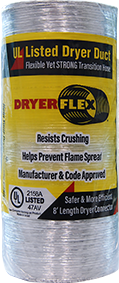Choosing the Right Duct

The dryer's transition hose can be an important factor in saving energy. It can also be a critical factor in protecting property and even lives. Why? Dryer-caused home fires have been documented at levels exceeding 14,000 a year. Flammable lint accumulates quickly in every exhaust system (even when the lint filter cleaned with every load). This can create a very real fire danger.
What's going on behind the dryer?
A big problem faced in laundry rooms is the crush point. Dryers naturally vibrate, or get pushed back against the wall. A transition hose that's not built strong (like every duct that was previously available before DryerFlex) can restrict airflow and actually increase the rate of lint accumulation.
The DryerFlex Advantage
Choose the Highest UL Fire Resistance Class
For safety reasons and added peace of mind, only UL2158A listed ducting, like DryerFlex, should be used to connect the dryer's exhaust system (non-listed hose such as that commonly used to vent bathroom fans should never be used). While building code and dryer manufacturers all require a UL 2158A listed transition duct, there are differences upon further testing. It is very common to find listed material that is fairly safe but does develop smoke and flame spread at lower temperatures. DryerFlex is the only flexible duct that has zero flame spread and zero smoke developed meaning it withstands fire exposure up to 482° with zero development of smoke or fire.
How DryerFlex Helps
- Makes Connecting and Cleaning Easier
- Helps To Protect Against Flame Spread
- Saves Money on Power Bills
- Lengthens Dryer Life

 DryerFlex Helps Protect Against Dangerous Kinks
DryerFlex Helps Protect Against Dangerous Kinks
